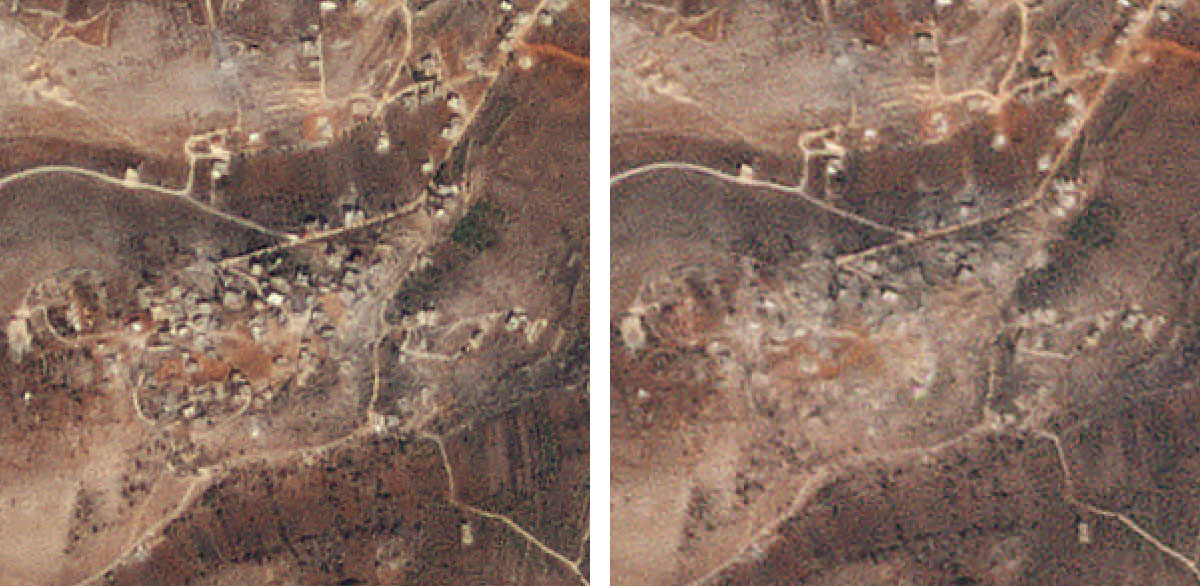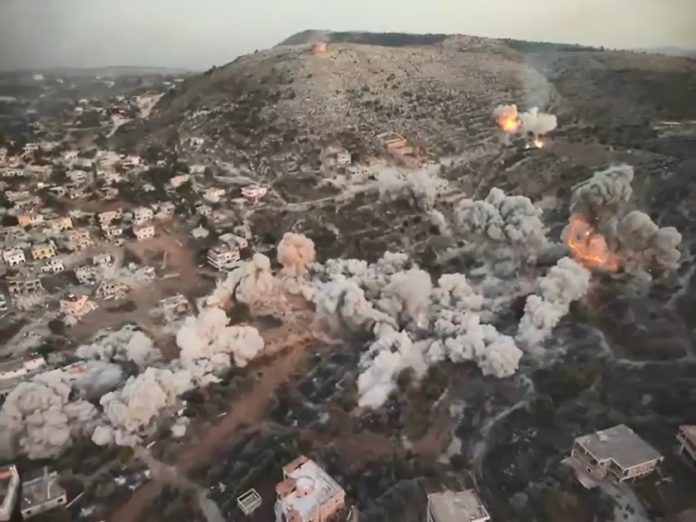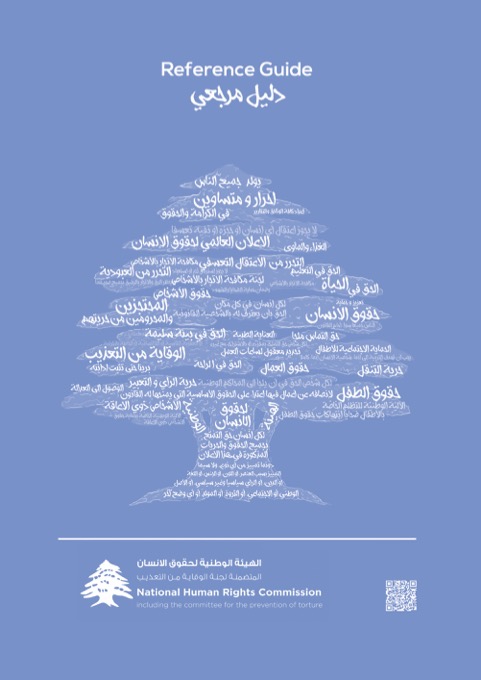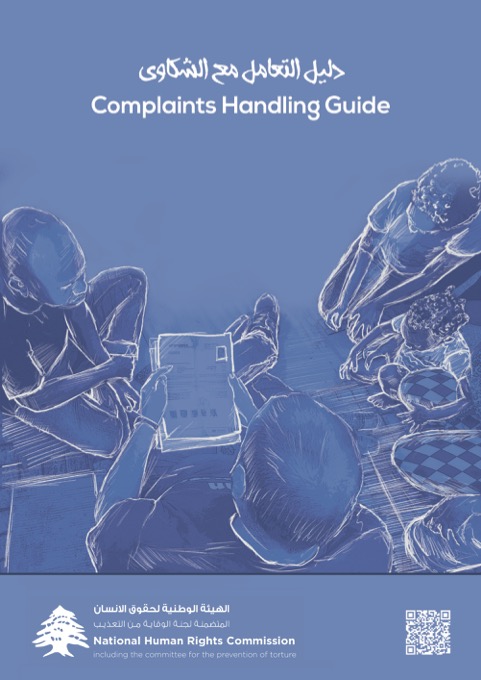هذه المقالة متاحة أيضًا بـ: العربية (Arabic)
The National Human Rights Commission, including the Committee for the Prevention of Torture (NHRC-CPT), stated that the Israeli military operation aimed at creating a buffer zone along the border in southern Lebanon, extending approximately 5 kilometers from the Blue Line, constitutes a war crime due to the wanton and systematic destruction it caused.
The Israeli army, using airstrikes, bulldozers, and manually controlled explosions, illegally demolished civilian buildings and leveled entire neighborhoods, including homes, schools, mosques, churches, shrines, and archaeological sites. Additionally, agricultural lands, water networks, power stations, solar energy stations, and artesian wells were destroyed.
Through the analysis of satellite images and videos shared by Israeli soldiers on social media between October 2023 and October 2024, the Commission’s International Humanitarian Law Violations Monitoring Team, in collaboration with several experts, identified several sites that were the wantonly and systematically destroyed in at least eight Lebanese villages. In some videos, Israeli soldiers can be seen preparing to take photos in celebration of the destruction as buildings collapse in the background.
Ali Youssef, NHRC-CPT Commissioner for complaints, stated: “The ongoing destruction campaign carried out by the Israeli army in southern Lebanon is a war crime. Research, media reports, and studies from several research centers, along with broadcasted videos, reveal that Israeli forces are completely removing residential buildings in a move intended to render vast areas uninhabitable.”
“The Commission’s monitoring indicates a consistent pattern along the Blue Line, aligning with the systematic destruction of entire villages. The destruction of homes and public facilities did not result from fierce battles but rather from deliberate actions by the Israeli army to destroy areas, mostly located on elevated ground, after seizing control of them.”
“Creating any buffer zone is a form of collective punishment against Lebanese civilians who lived in those villages. The repeated violations of international law by the Israeli occupation forces, under the pretext of resettling settlers, reflect nothing more than wanton and systematic destruction and collective punishment of the population.”
“The ongoing destruction campaign carried out by the Israeli army in southern Lebanon is a war crime. Research, media reports, and studies from several research centers, along with broadcasted videos, reveal that Israeli forces are completely removing residential buildings in a move intended to render vast areas uninhabitable.”
Ali Youssef, NHRC-CPT Commissioner for complaints
Israeli officials acknowledged the destruction of facilities along the Blue Line as a security measure to protect Israeli settlers, taken in response to Hezbollah’s attacks since October 2023. The Israeli army justified the demolitions, which began with the announcement of a ground offensive in southern Lebanon, by claiming they were destroying Hezbollah tunnels and military sites.
In the eight villages investigated by the National Human Rights Commission—Yaroun, Maroun al-Ras, Aita al-Shaab, Mhaibib, Kfarkila, Adaisseh, Houla, and Aitaroun—the demolitions occurred after those areas came under the operational control of the Israeli army, through ground advances and airstrikes carried out by warplanes, drones, and artillery shelling. This means the destruction did not result from direct combat between the Israeli army and Hezbollah. In these parts of southern Lebanon, structures were deliberately and systematically demolished.
The Israeli forces destroyed most of the village of Mhaibib on October 16, 2024, in a series of explosions, according to verified videos and satellite images published by several newspapers, including The New York Times. About twenty buildings were demolished in Mhaibib, about one and a half kilometers from the Blue Line. In a widely circulated video shot from a distance, soldiers wearing Israeli military uniforms are seen reacting with amazement, speaking in Hebrew as they watch the buildings explode simultaneously. The source of the video could not be determined. Still, it depicts the same demolition shown in another video broadcast by an Israeli radio station, where Israeli soldiers are seen giving thumbs-up gestures as they watch the buildings’ destruction on a drone controller screen. Satellite images of the village taken before and after the explosions show that only a few buildings remained standing after the Israeli operation, which a military statement said was carried out by Division 91. Among the buildings that seem to have survived is the shrine of the prophet Benjamin, the son of Jacob, a religious and historical site in Jabal Amel dating back over 2,000 years. It was impossible to determine whether the images damaged the shrine.
Tank tracks crossing into the village of Yaroun can be seen in satellite images taken on October 5, 2024, by Planet Labs, a commercial satellite services company. Newly created dirt banks are also visible, where the Israeli army established positions for tanks and other military vehicles.

Over a week, the Israeli army leveled large parts of the villages of Maroun al-Ras and Yaroun, which are visible in videos filmed by the Israeli military. Videos and photos showed Israeli soldiers patrolling the streets and setting up positions along houses. One video showed soldiers raising the Israeli flag over a destroyed park in Maroun al-Ras.
Most residents of the border villages had left their homes since the confrontations began in October 2023. Before the Israeli occupation forces’ ground offensive, rocket strikes throughout the year had already caused damage in Yaroun, as shown in satellite images from the summer. However, new satellite images show fresh destruction since the ground offensive began, with a complete section of Yaroun and Aita al-Shaab destroyed after Israeli military vehicles ravaged the area.
In the first week of this month, which saw heavy bombardment, intense airstrikes, and ground operations accompanied by demolitions and land clearing, it became clear that more buildings were destroyed than before. Large areas of land also appeared to be burned.
Similar scenes of destruction can be seen in neighboring Maroun al-Ras, where recently demolished buildings and a devastated area are visible, along with Israeli military vehicles. More buildings seemed recently demolished, and part of the village was leveled. Among the regions flattened was the “Iran Park,” which contains a mosque designed to resemble the Al-Aqsa Mosque in Jerusalem.
A video circulated on social media shows what appears to be a controlled explosion that destroyed a historical mosque in Yaroun, over 300 years old, which served as the principal place of daily prayers and religious celebrations. Satellite images also revealed that two other mosques were recently destroyed in Maroun al-Ras. A Catholic church in Yaroun was also destroyed, along with a health clinic and the shrine of Al-Khidr, revered by both Muslims and Christians. Satellite images show that a significant portion of the Catholic church’s roof had collapsed. It is believed that Israeli occupation forces’ bulldozing operations in Yaroun affected an archaeological site on Tell Aar near the border fence.
A video circulated on social media on October 28, 2024, appears to show a controlled explosion carried out by the Israeli army to demolish homes in the town of Aitaroun in southern Lebanon. This indicates that the wanton and systematic destruction is based on a well-planned strategy executed by the Israeli army as it expands its control over land, regardless of whether it establishes permanent positions there or withdraws under resistance attacks.
International humanitarian law imposes strict restrictions on the destruction of enemy property in armed conflicts. Such destruction is only permissible in cases of absolute military necessity and prohibits directly targeting civilian facilities. The concept of military necessity allows combatants to take necessary actions to weaken their enemy’s military capabilities, provided these actions comply with international humanitarian law. Destruction of property is excluded from prohibition in cases of absolute military necessity as long as it serves a legitimate military purpose and observes the principle of proportionality. For example, destroying a site used by the enemy as a firing point during direct combat would be legitimate. However, this does not apply to what happened in the eight Lebanese villages, as they were under Israeli control at the time of the demolitions, either through controlled explosions or intense aerial bombardment without any military target. Even if there were a legitimate military objective, the scale and method of destruction must be proportionate to the target and comply with military occupation laws.
The National Human Rights Commission, including the Committee for the Prevention of Torture, reiterates its request to the UN High Commissioner for Human Rights, Volker Turk, to convene a special session of the Human Rights Council on the graves human rights situation in Lebanon and for this council to urgently adopt a resolution establishing an ongoing independent international commission of inquiry to investigate all violations of international humanitarian law and all human rights violations and abuses that occurred before September 22, 2024, and have happened since that date.
The Commission also reiterates its call for the Lebanese government to make an urgent decision regarding the role of the International Criminal Court by swiftly instructing the Ministry of Foreign Affairs to submit a declaration to the ICC Registrar accepting the court’s jurisdiction to investigate and prosecute crimes under the court’s jurisdiction on Lebanese territory since October 7, 2023.
The Commission has issued urgent calls to the UN Human Rights Council’s Special Procedures to form a delegation of several Special Rapporteurs to visit Lebanon to investigate human rights and humanitarian law violations committed as a result of the Israeli aggression against Lebanon. The Commission suggests the delegation include the Special Rapporteur on the promotion and protection of the right to freedom of opinion and expression in defense of journalist safety; the Special Rapporteur on extreme poverty and human rights; the Special Rapporteur on extrajudicial, summary, or arbitrary executions; the Special Rapporteur on the right of everyone to the enjoyment of the highest attainable standard of physical and mental health; the Special Representative of the Secretary-General on the human rights of internally displaced persons; the Special Rapporteur on adequate housing as a component of the right to an adequate standard of living; the Special Rapporteur on the right to food; the Special Rapporteur on the rights of persons with disabilities; and the Special Rapporteur on the implications for human rights of the environmentally sound management and disposal of hazardous substances and wastes. The Commission hopes the delegation will be able to visit affected areas, gather testimonies from victims, and engage with relevant stakeholders in Lebanon to ensure the protection of human rights. The Commission affirmed its full readiness to cooperate with the Special Rapporteurs and provide all necessary support to ensure the success of these visits.
Background
International humanitarian law applies to situations of armed conflict, including military occupation, and consists of rules designed to minimize human suffering during such conflicts to the greatest extent possible. The four Geneva Conventions of 1949 and their two Additional Protocols of 1977 are the principal instruments of international humanitarian law. Many of the rules in these treaties are part of customary international law, meaning they are binding on all parties in any armed conflict, regardless of whether they have ratified specific treaties, whether they are state forces or non-state armed groups.
According to this customary law, “the destruction or seizure of enemy property is prohibited unless imperatively demanded by the necessities of war.” Furthermore, under Article 53 of the Fourth Geneva Convention, which governs Israel’s actions as an occupying power in Gaza, “Any destruction by the Occupying Power of real or personal property belonging individually or collectively to private persons, oo the State, or to other public authorities, or social or cooperative organizations, is prohibited, except where such destruction is rendered necessary by military operations.”
Article 147 of the Fourth Geneva Convention stipulates that “extensive destruction and appropriation of property, not justified by military necessity and carried out unlawfully and wantonly” constitutes a grave breach of the convention and, thus, a war crime.
When such destruction is carried out as a form of collective punishment, it violates Article 33 of the Fourth Geneva Convention: “No protected person may be punished for an offense they have not personally committed. Collective penalties and likewise all measures of intimidation of terrorism are prohibited.”
The civilian property also enjoys protection during armed conflict under the principle of distinction, which obliges the warring parties to always distinguish between “civilian objects” and “military objectives” and restrict their attacks exclusively to military objectives. Under customary international humanitarian law, civilian objects are all objects that are not “military objectives.” Military objectives concerning objects are those which, by their nature, location, purpose, or use, make an effective contribution to military action and whose total or partial destruction, capture, or neutralization, in the circumstances ruling at the time, offers a definite military advantage. Civilian objects are protected from attack unless and for such time as they become military objectives. In cases of doubt, the First Protocol requires warring parties to presume that an object remains civilian. Intentionally directing attacks against civilian objects is considered a war crime.


